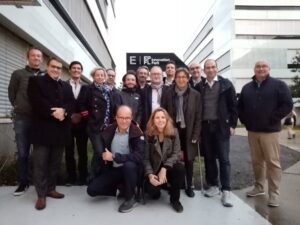💡 Silicon Valley, or the success of customer-facing business models
💡 Silicon Valley, or the success of customer-facing business models
by Joëlle Touré, delegate general, Futura-Mobility
Monday 8 October, 2018, InnoCherche, the innovation think tank for business leaders, presents the findings from its field trip to Silicon Valley.
“We are witnessing the end of an era,” said Bertrand Petit, president, InnoCherche. The spirit of Silicon Valley, described as an all-out collaboration between companies, start-ups and research, is disappearing in favour of a more individualistic and even politically correct attitude towards regulations, and even ethics, too. It is certainly the first time one encounters attitudes such as: “it’s not me the bad guy, it’s Facebook!“
To a certain extent, this is another illustration of what Eric Sadin highlighted when speaking to Futura-Mobility (in May 2018) about “the end of entrepreneurial savagery (innovation outside the scope of any regulation), and above all the ability of society to integrate these actors and initiatives.”
The Silicon Valley ecosystem is described by Carlos Diaz, a Silicon Valley-based consultant and investor, as “the Everest of marketing” open for ascent by the whole world. For investors, it is all about “chasing unicorns”. By investing in 40 start-ups, they hope that two of them will multiply in value X45. As a consequence, even if the other ‘deals’ are losses, they still win. By comparison, US$35 billion are ploughed into Silicon Valley every year compared to US$3 billion in Israel or France….
Today, China has more unicorns than Silicon Valley and around the same number as in the whole of the US. A reality that prompts Bertrand Petit to say “go West, young man” in reference to the California Gold Rush… China being in the West from a US perspective.
Certainly of greater interest is understanding the undisputed and global success of these American behemoths, with Amazon heading the pack. Mr Petit believes this success is not down to the fact they were born “digital” but rather born “customer-centric”, unlike industry groups several decades old! “The big companies have had to go through all the revolutions – from digital to open innovation not to mention customer focus,” he added, “but what’s important is going even further to become truly customer centric.”
To illustrate his point, he referred to Las Vegas-based Zappos. The online shoe and clothing merchant gives every team member in its customer services a US$1,500 envelope to keep the clientele happy. For instance, one of the service staff resent some shoes – plus a huge bunch of flowers – to a client at the wedding venue she was due to attend; what’s more, by express delivery… because the first delivery hadn’t arrived in time. Cost of the operation: over US$600.
This strategy drastically changes how a company is managed, including its accounting. One business, Zuora, praises this subscription economy, which is today proving more lucrative than the traditional model of selling products to be owned. Basically, the business model of Free (freedom to leave the service at any time, only pay what you consume) versus that of Canal+ (fixed subscription with pay-for extra options, irrespective of the real consumption).
To sum up, the key indicators become customer churn, cross-selling, up-selling, turnover per customer, and so forth. And EBITA is reinvested to recruit new customers. The logic here is that R&D and innovation shift higher up the value chain to both retain existing customers and attract new.
In the field of mobility, Ford’s shift from the black car for all (because the paintwork dries faster!) to one better suited to the needs and expectations of the individual, is one example of a ‘customer focus’ rather than a ‘customer centric’ approach. According to Mr Petit, finding the key to ‘customer centric’ is easy. Simply ask yourself: “what’s the point of the product? The client’s need isn’t to have a car (= customer focus) but instead a mobility solution (= customer centric) for going to work the next day or ferrying their children to and from their extra curricular activities.”
This thinking largely reflects the work of Futura-Mobility, during the first half of 2018 – strategic disruption and the mobility industry – particularly the emergence of ‘all-as-a-service’, where a shift in identity from ‘builder’ to ‘mobility operator’ can be observed among certain industry members.
The risk highlighted by these different trains of thought is that companies must take care not to pay so much attention to services (as they previously did with products) that they lose sight of their customers. Focusing on a service drastically changes a company’s business model. Once the change is made, one downfall could be that the company crystallises around well-defined service – to such an extent it loses sight of the real needs of its customers … likewise for a product-centric organisation!
The real change in direction to be taken is surely that flagged up by Jean-Pierre Farandou, for instance, during his presentation to Futura-Mobility (April 2018): customer focus, enabled by detailed knowledge and, even further, anticipating their needs tomorrow.
Cover photo: Flickr/cc – Patrick Nouhailler


